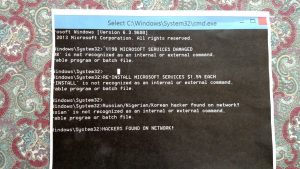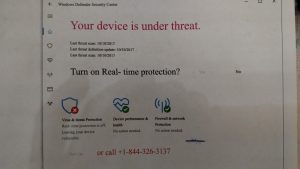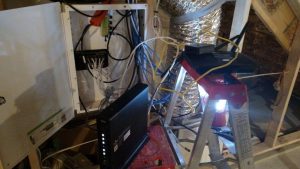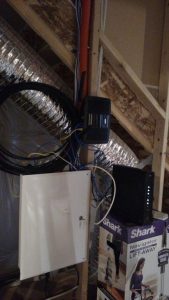Song Director 2.01 version is a major update. It has many new features and updates. Released in January 2020..You can download the new version 2.01 at http://songdirector.com/download/
All posts
New versions of Song Director released in 2018
There have been some new versions of Song Director released in 2018.
To know which version you are using go the pull down help menu and choose “about”
To get the latest version, simply download Song Director again from the website and install it into the same location as before, just like the first time. The setup program will not overwrite any of your existing data. Here are the changes:
All posts
Microsoft SCAM Solved
I went to fix a computer from a customer in Erie, Colorado who got scammed from someone that took over their computer on remote access saying they were from Microsoft.
I traced the steps.Very interesting what they did they use the command prompt to put fake commands in saying that hackers were infiltrating your system and they needed to pay money to fix the issue. They said they were from Microsoft and need to fix the problems created by the hackers.
There are no hackers they put fake messages in certain places where you check the system for errors. Here’s a printout of the Windows command prompt with bogus information
People who are not technicians are fooled by this. but this is a command prompt this is not a error screen. That’s why it says it’s an unrecognized command Copying and pasting bogus error information in the command prompt you supposed to only be typing commands People get confused by this who don’t know about computers.
Saying that you must install Microsoft services at $1.54 a piece 198 times for each service. Then they take the credit card information charge your credit card for that and God knows for what else. They also did other things working very fast having the customer do things on the computer to distract your attention and having a lot of pop-up screens. While taking over the computer with remote access.
I was able to undo any damage they caused and get the computer back up and running like before. So in the end I fixed the issue. But people need to call Computer Physicians if they get a problem with their computer so that they don’t cause more issues or problems. This hacker could have done worse if the customer did not call Longmont Computer Physicians to come solve the issue.
All posts
Computer Networks in Longmont Denver Erie Colorado Computer Physicians
Networking is one of the jobs that Longmont Computer Physicians, LLC does to help it’s clients. Sometimes it is wireless networks, other times the client wants a wired computer network.
I needed to hard wire an entire house with CAT5e cabling for a client a few months ago for internet and file sharing access. It was a great success! 8 rooms in the house had access to a network cable for computers.
Here are some pictures of the job of the patch cables and routers running into the house and through the walls.
PC Computer Networking in Longmont, Boulder, Denver, Erie Colorado
All posts
Computer Repair Windows update in Longmont, Boulder, CO
Our Longmont Computer Physicians, LLC office computer had an interesting issue recently I thought I would share:
After an automatic installing of windows 10 update for Valentine’s Day Feb 14, 2018 (KB4074588) my USB keyboard on my desktop computer would no longer work. I tried 3 different USB keyboards – none worked. So I went into device manager to uninstall, reinstall, and update the keyboard drivers. That did not work. So then I uninstalled the windows update. This fixed the problem, but the update would try to install again the next time I reboot. So I set the windows update to never install hardware drivers during the update in (system properties) I would need to choose what driver update I want manually from now on.
Computer Physicians provides PC computer networking, repair, Data Recovery, training and virus removal in Longmont, Boulder, Denver, Erie Colorado and the Colorado Front Range
All posts
Introducing NameBase – People Organizer Software
NameBase is a program that keeps track of names, addresses, phone numbers, dates, notes, reminders, and other miscellaneous data about persons and organizations. A unique feature allows you to organize entries into any category you wish, then view these categories separately or combined.
Download NameBase for FREE:
NameBase will automatically remind you of birth dates, anniversaries or any other dates, even if they are not associated with a specific individual in the database.
Find any person in the database by simply typing the first few characters of their name. As you type, NameBase immediately zeroes in on the record you want.
NameBase includes a feature that lets you specify any criteria to further limit the records displayed or printed. You can then view, edit, or print just the records you selected. You can search for any string of characters in all records.
You can easily select one or any number of records for printing, with one click of the mouse. You only have to deal with the records you want, not the entire database.
NameBase lets you sort on any field, and print reports in any order. You can edit a record in a spreadsheet-like grid or on a separate edit screen. Many fields have user-customizable screen labels.
Various printed reports are included. There are address books in different sizes, from full-size to pocket-size. You can specify the font, font size, and starting position for mailing labels and envelopes.
NameBase uses a Microsoft Access database, so it’s easy to access your data using many other products such as Word, Excel, and Access. You can even write your own reports using these products. Mail merge is a snap using most any word processor.
Why You’ll Love NameBase
Why you’ll love NameBase – by a highly enthusiastic user
Simply put, everyone in the modern world has a crying out need for NameBase. It provides the simple and perfect way to organize all your phone numbers, addresses and personal notes into a form you can access in a split second.
If you use a computer and make telephone calls on a regular basis you’re sorely in need of NameBase. And every passing day increases your need for this simple, yet incredibly powerful NameBase system. Here’s why….
Most people don’t yet carry a computer with them wherever they go. That’s why NameBase allows you to print the neatest and most comprehensive personal phone books you’ve ever used. Now you can enter your data once and print identical personal phone books for your home, workplace, car, briefcase, vacation home or whatever. Say “good-bye” to having three or more different phone books each containing some revisions which did not get transferred into the other phone books. What a pain! Now you can update NameBase once and know that this suffices for all copies of every phone book you’ll produce in future. Also say “au revoir” to trying to cram someone’s new cellular phone number into a tiny space in your phone book; a space really only big enough to hold four characters!
Of course there are other phone and address packages on the market. I downloaded or purchased at least 15 others before I hit on NameBase. You can do the same if you like, but if you want a tip, save yourself the time and trouble.
NameBase is going to save you much time, hassle, and frustration. At the same time you’ll find your efficiency level has taken a quantum leap. You’ll wonder how you ever got along without NameBase. Right now you simply don’t know what you’re missing. But you’re about to find out.
Nowadays, like it or not, phones, faxes, cellular phones, e-mail and the Internet play an increasingly dominant role in everyone’s lives. This trend is rapidly increasing. Even the most technology resistant person now sees the writing on the wall. You either embrace some or all of the modern communications advances or become a “have not” in more ways than one; someone who has to settle for second best when it comes to vocations, social acceptance and many other aspects of life. We don’t have to like it but we all need to face it. Luckily, the more we get into it the more interesting, helpful and enjoyable it all becomes.
The great thing about NameBase is that no matter what your current level of computer literacy, NameBase adapts itself to your level of expertise. That’s a pretty flamboyant statement, yet it’s completely true. Just install this free sample of NameBase and test drive it for yourself.
Provided you’re in one of the following categories, you’re bound to love NameBase as much as I do.
GROUP 1. (Light & Easy Users)
You just want a good, easy, name/address and phone book. You want enough room to store numbers for home and work phones, faxes, cellular phones, toll-free numbers, e-mail addresses and the like. Perhaps you also want to give each number a meaningful descriptive label? No problem; it’s easy to do.
You’d prefer to maintain a single phone book which covers the entire family. You want to print a number of updated phone books whenever you have the need.
You’d like the option of assigning contacts to your own specified categories, for example, Office, Church, Customer, Relative, Sports Group, Lions Club, Christmas Card Recipient or whatever. You may want to print mailing labels or a list of any such category. You’d like to store your bank account or credit card numbers with your other bank details, your Frequent Flyer Number with the airline’s details or your account number with the power company’s details and so on.
You’d like to find that really reliable plumber whose name you’ve now forgotten. Then there’s that nice couple you met on your 1996 vacation. They lived in Chattanooga (love the sound of that town) but what the heck were their names and phone number?
On the other hand, perhaps you’re a corporate user who simply wants an easy way to create and maintain an in-house phone book for all persons in all branches of the company. You want something which can be easily distributed to needy colleagues throughout the organization as circumstances require. You’re driven to distraction as a result of people switching desks, offices, cars and hand-held cellular phones.
Well for all you folks in Group 1, it seems like NameBase is a natural for you.
GROUP 2 (A Little More Ambitious)
You work with a notebook or desktop computer beside you most of the day and you want the same things as Group 1, plus more. You want to have NameBase running in Windows all the time so you can pop it up in an instant. You want to just type a couple of characters of a person’s name to have everything leap to your screen in an instant.
You want to quickly type a few notes about many of your conversations as you’re talking with individual customers, suppliers, sales prospects, tardy debtors etc. and save them for future reference during your next phone call. You want to find any text anywhere in your database by simply typing that text and pressing a “Find” key. This looks like a job for NameBase!
GROUP 3 (The Power User)
You want all the Group 1 and 2 stuff plus more. In short, you’re a “power user” with no time to spare or simply someone who wants everything!
I suppose you have a modem permanently attached to your computer and just want to click on a phone number and have your modem automatically dial for you. You probably want to be able to specify filters and SQL to select specific records or print a report. Maybe you’d find it useful if NameBase was based upon the Microsoft Access database engine (it is), so you can write your own reports using that program. These and loads of other powerful features are available in NameBase.
NameBase and Song Director was developed by Computer Physicians, LLC – A Computer Repair company based in Longmont, Colorado, USA.
NameBase is available for FREE download.
All posts
Boulder/Longmont Computer Repair – PC with no hard drive used
Longmont Colorado PC Computer not using it’s hard drive:
Computer Physicians, LLC just worked on a unusual situation on a Zotac mini PC computer in Longmont, CO that had a boot windows drive that was filled up. I thought this would be good to share with my readers:
This very small Zotac mini PC computer running Windows 10 home with 4GB of RAM was booting to a 64GB memory chip located on the motherboard and was not using the 300GB internal SATA hard drive. As a result since the Windows OS was on a small 64GB memory chip it quickly got filled to capacity. I backed up the customer’s data to an external hard drive. The internal hard drive was not being used except for the storing of a few small files. I could not clone the 64GB memory chip but was able to transfer the OS using special disk software. I then needed to go into the BIOS and set the boot drive to the internal drive. The computer is running slower now since it is not using the small 64GB memory chip for windows and the CPU and computer itself is an inexpensive under-powered computer which was designed to run on the 64GB memory chip. The problem with this design is that the 64GB memory chip quickly gets filled to capacity. (Windows 10 uses a lot of hard drive memory most systems have 1000GB or more)
I do not like this design and would not recommend this Zotac computer to a client.
The computer will run faster if the original drive is replaced with a solid state drive and if the OS can be transferred and if more RAM memory is installed.
These are some of the situations that Computer Physicians, LLC runs into.
-Steve
All posts
Longmont’s Computer Physicians Computer Service and Repair in Longmont Colorado
Computer Physicians, LLC is a computer service company in Longmont, CO in business since 1999.
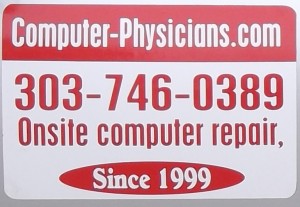
We provide computer repair and other services onsite at your location for same day service or in our workshop for the lowest cost in the area.
We also provide: Computer training, tutoring, help, upgrades, computer systems, rentals, sales, troubleshooting, performance improvement, cyber security, virus removal, networking, website development and hosting, internet setup, router and switch install and we can use our 1gbps upload and download internet service connection at our office for any fast internet needs you have. We are experts at Data Recovery of lost data and PC system crash recovery. We also develop, program and create Song Director and NameBase database software.
Computer Physicians services the entire Colorado front range. Our main technician and president is CompTia A+, MCP, MTA Microsoft certified professional with many college degrees in computers.
Call us today for any of your computer needs.
All posts
Longmont’s Newest Computer Viruses – Longmont/Boulder CO – Computer Physicians
Computer Repair Longmont, CO Virus removal. – Computer Physicians, LLC
Here is some news about the latest computer viruses out today that Computer Physicians in Longmont/Boulder, CO can help you with:
Technewsworld:
A new ransomware exploit dubbed “Petya” struck major companies and infrastructure sites this July 2017, following last month’s WannaCry ransomware attack, which wreaked havoc on more than 300,000 computers across the globe. Petya is believed to be linked to the same set of hacking tools as WannaCry.
Petya already has taken thousands of computers hostage, impacting companies and installations ranging from Ukraine to the U.S. to India. It has impacted a Ukrainian international airport, and multinational shipping, legal and advertising firms. It has led to the shutdown of radiation monitoring systems at the Chernobyl nuclear facility.
